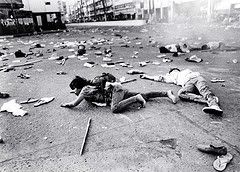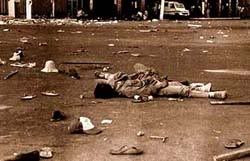

Mendiola Street is a short thoroughfare in the district of San Miguel in Manila, the capital of the Philippines. Mendiola Street starts from the intersection of Legarda and Claro M. Recto Avenues and ends just outside Malacañang Palace, the official residence of the President of the Philippines. Mendiola is famous for being the venue for protest actions against an incumbent government and is the site to some colleges and universities that form the area of Manila known as the University Belt.
Because of the tight security at the Malacañang Palace, authorities decided to close half of Mendiola Street starting from the sentinel gate in front of the College of the Holy Spirit and La Consolacion College to protect the palace from different forms of threats. Vehicles were then diverted to Concepcion Aguila Street, a narrow side street that passes through residential areas of San Miguel.
Mendiola Street has been the site of violent confrontations between protesters and government troops:
1970
During the administration of Ferdinand Marcos, Mendiola Street was the site of the "Battle of Malacañang" or "The Battle of Mendiola Bridge" on January 30, 1970 which resulted in the deaths of four student demonstrators.
1987
On January 22, 1987, crowd control troops opened fire on a protest rally of about 10,000 peasant farmers demanding genuine land reform from then President Corazon Aquino. Thirteen of the protesters were killed and hundreds injured in the incident now called the Mendiola massacre.
2001
On May 1, 2001, supporters of President Joseph Estrada, angered by his arrest following his ouster from power earlier that year, marched to Mendiola Street after staging demonstrations outside the EDSA Shrine demanding the release of Estrada. A violent confrontation ensued between Estrada supporters and members of the Philippine National Police and the Armed Forces of the Philippines, who were then tasked by President Gloria Macapagal-Arroyo to secure Malacañang Palace and the areas surrounding it. Mendiola Street and the vicinity around Malacañang Palace became a front line after the protesters tried to storm the Palace. Casualties were high on both the Estrada supporters and government troops. Damage to property along Mendiola Street and areas within the vicinity of Malacañang Palace cost millions of pesos as a result of looting of stores and shops and burning of several government and private vehicles by the protesters. Later, President Gloria Macapagal-Arroyo declared a State of National Emergency but lifted it after two days.







No comments:
Post a Comment